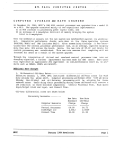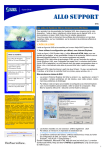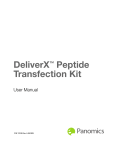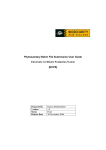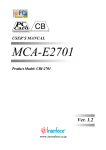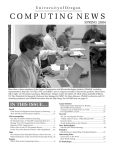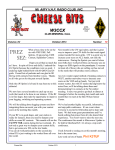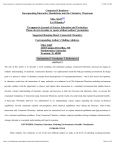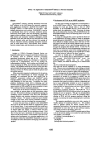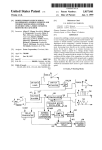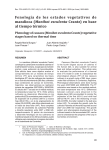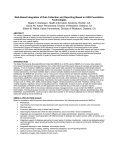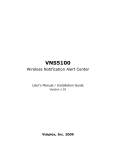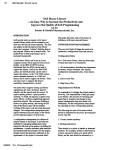Download Get Nov 2001 Newsletter - The Hartford Area SAS Users Group
Transcript
HARTFORD AREA SAS® USERS GROUP
Volume 13, Issue 4
Fourth Quarter, November 2001
Table of Contents
Note from the Chairman
2
Meeting Announcement
2
Sponsorship Policy
3
Recruiting Policy
3
Calendar of General Meetings and Conferences
3
Calendar of Steering Committee Meetings
3
August Highlights
4
HASUG Email Distribution List
4
Book Review
5
Continuing with Education
6
Hyperlinks of Interest
6
Editorial and Production Staff
6
Tips and Techniques, Disclaimer
7
Tip Index
7
Consultants Speci al Interest Group
8
Tips and Techniques
9 to 14
Steering Committee
15
Directions to the November meeting in Wallingford
15
The HASUG Flash is available for reading on the World Wide Web at http://www.hasug.org
SAS is a registered trademark of SAS Institute Inc. Cary, North Carolina
1
The first featured presentation will be "I'll Have
the TABULATEs a la ODS Please, With a Table of Contents On the Side given by Ray
Pass. The advent of the Output Delivery System (ODS) in Version 8 of the SAS System is
truly monumental in scope. It required rewriting
all SAS Procedures that produce output (not all
do) and splitting out their “data components” from
their “table definitions” (presentation format templates). SAS users now have the ability to combine these components into customized “output
objects” and to send them to different output
“destinations”, including casting them as HTML
pages.
Note from the Chairperson
Barbara Moss, CIGNA
Similar to so many people, I gathered around the
nearest radio in an otherwise eerily still office
building the morning of September 11th. Listening to the tragic events unfold, has bound me to
the airwaves, and has drawn me back each day
since. Through the news, commentary, and talk
shows one idea has stayed with me, perhaps because it is actionable. That is the notion of appreciating those around us and living each day to
the fullest.
The HTML destination gives users the ability to
produce our main content output as one component frame of a multi-frame page. The other possible component frames can be either
proc edure output or a Tables of Contents (ToC). Although there are methods for customizing the
contents of the ToC frames, they still do take up
valuable screen real estate. This paper demonstrates a methodology for creating a separate
stand-alone Table of Contents for a multi-output
ODS-HTML run, with navigational tools included
to go back and forth between the ToC and the
content pages. Other data-driven techniques are
also demonstrated for renaming ODS-HTML generated sequential body file names into more
meaningful content-oriented names. The techniques are not difficult when based on the power
of ODS and simple SAS programming tools.
I realized that among the people in my Ground
Zero and Pentagon circle of concern, were folks
I've met through user groups, including members
of the HASUG steering committee. Our local
user group brings in people from all over the
state, including commuters into New York City.
National and international conferences - the
friendliness of SUGI attendees is outstanding have given me friends around the country.
As much as there is the chance that each
HASUG meeting will offer me a piece of SAS
knowledge to make some task easier, I look forward also to seeing the people. Certainly, the
work, time and effort contributed to run a HASUG
meeting is appreciated, but the success of the
group can be attributed just as much to the
community of the people.
Ray Pass, Ph.D., of Ray Pass Consulting, is an
independent SAS consultant and has been using
the SAS System for too many years. He is the
co-author, with Ron Cody, of "Programming SAS
by Example" (1995) and has delivered many invited papers at national, regional and local SAS
user groups. Ray's primary areas of expertise in
the SAS System are report generation and
data manipulation. In addition to teaching SAS
courses, Ray has also been quite active in
organizing and participating in SAS user group activities on various levels. Ray was one of the
founders of both the New York Area SAS Users
Group (NYASUG) and the NorthEast SAS Users
Group (NESUG.) Ray co-chaired the first two NESUG annual conferences ('88, '89) and has been
a Section Chair at many SAS User Group International (SUGI) annual conferences.
As always - actually more than usual - I look forward to seeing all of you at the next HASUG
meeting.
November Meeting Announcement
The fourth quarter HASUG meeting is to be
held on Wednesday, November 14, 2001,
9:00 a.m. to 11:30 at Bristol-Myers
Squibb, Research Parkway, Wallingford,
Connecticut. Please note that this meeting
is being held on a Wednesday instead of
our traditional day, Thursday. Our host
asks that you pre-register for the meeting via
email by sending a message with your name
to the address :
[email protected].
(Continued on page 3)
2
The HASUG Recruiting Policy
(Continued from page 2)
The other featured presentation will be "Using
SAS ODS to Create Professional-Quality Reports " given by Rob Krajcik. The SAS Output
Delivery System (ODS) can create Rich Text Format (RTF) files with little coding effort. This presentation will show some of the steps the author
went through to get from a standard line printer
listing to an RTF document.
HASUG’s primary mission is to provide a forum
for SAS professionals to meet and share experiences. HASUG also recognizes that searching
for new employment opportunities is a normal
activity when professionals meet. Since we
depend on our respective employers to support
HASUG by providing time for members to attend,
prepare presentations, and provide meeting
facilities, we do not wish to jeopardize those
relationships we have all nurtured.
Rob Krajcik is a Principal Analyst in the
Biostatistics and Data Management division at
Bristol-Myers Squibb in Wallingford, Connecticut. Prior to joining Bristol-Myers Squibb, Rob
was a consultant for pharmaceutical and health
insurance clients. His early involvement with
SAS, which goes back to the days when SAS
was housed in a single building, was using MICS
and MXG to undertake MVS capacity planning
and performance management. Rob has successfully completed SAS V6 Certification.
Therefore, when attending any of our quarterly
meetings, we request that all parties engaged in
recruiting activities be "professional and
discreet", and suggest that such activities be
carried outside and after our meetings. Those
seeking or offering positions may display
materials at a location designated by HASUG at
each quarterly meeting. The materials may
include resumes, job openings, contract
opportunities, business cards, etc. None of the
materials may include salary information. All such
materials left after the meeting will be discarded.
Violators of this policy may be asked to leave the
meeting.
SAS is a registered trademark of SAS Institute,
The HASUG Sponsorship Policy
All parties are encouraged and welcome to
attend our quarterly HASUG meetings scheduled
during the months of February, May, August, and
November of each year. Usually these meetings
are scheduled the 3rd Thursday from 9:00 am to
noon at various locations throughout Connecticut.
Past locations have included Hartford, Meriden,
Middletown, Norwalk, Glastonbury, and New
Haven. We are always looking for new hosts
within the state of Connecticut. If you feel your
organization can host a meeting of up to 70 or so
people, please contact one of the Steering
Committee members.
For other recruiting opportunities, please see the
SAS CONSIG article elsewhere in this newsletter
or visit www.sconsig.com.
Calendar of Events
Future General Meetings and Conferences:
November 14, 2001
February 21, 2002
April 14-17, 2002
May 16, 2002
Bristol-Myers Squibb, Wallingford, CT
The Hartford, Hartford, CT
SUGI27, Orlando, FL
Purdue Pharma, Stamford, CT
HASUG Steering Committee Meetings:
November 14, 2001 Immediately after HASUG meeting
December 13, 2001 Conference call, 12:00 -1:00
February 21, 2002 Immediately after HASUG meeting
March 21, 2002
Conference call, 11:30-12:30
May 16, 2002
Immediately after HASUG meeting
3
August Highlights
Change to HASUG
Bernard M. Dubb, Online Associates
Barbara Moss, Cigna Managed Care Systems
Email List Distribution
The August meeting of HASUG was held at the
SAS Institute Hartford Regional Office in Glastonbury. Thank you to Linda Kestenbaum for
welcoming HASUG to their bright and comfortable site with fine meeting accommodations, food
and drink and an unexpected gift bag for each
attendee.
The HASUG Email List Distribution has changed
within the past year. In most aspects, the process
and privacy issues remain the same as before.
The only obvious difference is when you sign up
to be a member in the HASUG.org web site, you
will see you have two choices to select which list
to join (HASUG Email or SCONSIG). You are
able to join either or both Email Lists at the same
time by MARKING the CHECK BOXes to the left
of each list.
Our first presentation was a wealth of information
presented by Sandy McNeill of SAS Institute.
Sandy presented, "Changes & Enhancements for
ODS by Example (through V8.2)" with all the examples promised. As manager of the Output Delivery and Reporting Department at SAS
Institute, she also gave hints, details, and
references that only an insider can share. For example, the best place to look for help on 8.2 topics,
including those for ODS, is the Online Help Doc umentation. Changes for 8.2 have been incorporated into the Online Help Documentation. On the
other hand, Online Documentation
presents
information separately by version. Online Doc is
a helpful source with the older features of the
product. For "all sorts of good information",
please see:
http://www.sas.com/rnd/base/index.html.
Select your interests
HASUG Email
SCONSIG
Both SCONSIG and HASUG share the cost to
make this feature available to its respective
members, and both lists are separate and
independent from each other.
If you were already a member prior to this
change, your membership has been automatically transferred to the new list, and you do not
have to do anything. However, in case you have
changed your email address rec ently, your
membership is automatically purged from either
list due to bounced emails.
HASUG’s own Michael Davis, an independent
consultant with Bassett Consulting Services gave
the second presentation. His presentation was
titled “Reading from Alternate Sources: What to
Do When the Input is Not a Flat File”. Michael
noted that while many SAS applications involve
reading either a SAS data set or a flat file, there
are situations that may require data to be
accessed from a web page, a TCP socket or
through FTP from a remote network site. The
presentation illustrated the new features in SAS
software to handle these and other data input
situations. Special attention was paid to version
7 and 8 features including the SAS/ACCESS
LIB NAME engines that address RDBMS data formats. As always, Michael’s presentation was illustrated by many examples. Michael continually
stated that in order to fully appreciate the beauty
and flexibility of SAS software you can try out
various features. One last tip was offered: if
OnlineDoc is not installed at a site, it is available
from the SAS web site at:
http://v8doc.sas.com/sashtml
The List automatically checks for valid email addresses and if any should become invalid, your
membership is cancelled without notice as your
email address is no longer valid, hence no way to
contact you.
If you do not get an email message from the
HASUG Email List Distribution within 3 months
(we normally send out messages once every 3
months to notify members of the upcoming
meetings and to inform each member a new
HASUG FLASH newsletter is ready for viewing),
it is recommended to re-join the list with your new
email address
.
.
4
cluding solutions to correcting these errors. In
Chapter 6 and 7, the SAS messages are grouped
NOTES first, followed by WARNINGS, and concluded with ERROR messages. Within each
grouping, the messages are alphabetically arranged. It is obvious Michele has spent considerable time writing this book by supplying examples
of SAS programs with errors, their messages,
and solutions to correcting these errors.
Book Reviews
Debugging SAS Programs: A Handbook of Tools
and Techniques
By Michele M. Burlew
Publication # 57743
Approx. Cost: Under $40.00
Janet Stuelpner, Citigroup
I highly recommend this book for beginners, intermediate and advance SAS professionals as an
excellent source for learning more about the SAS
system, debugging your own SAS programs as
well as programs written by other SAS professionals. Having used the SAS Software for 20
plus years, there were some errors in this book I
have never seen before; either I programmed
very well (GRIN) or there are some places I have
never ventured to within the SAS Software.
They say that if ten programmers are given the
same task, they will come up with ten different
methods to achieve the same results. With that
in mind, below are two differing points of view on
the same book. Both reviewers agree that the
author attempted a Herculean task in writing
about debugging code and the associated error
messages, including what those messages
mean. The book is chock full of useful information that can’t be found elsewhere. Where we
differ is whether book successfully addresses the
topic. So, here is the HASUG version of point/
counterpoint.
Caution should be used when reading this
book – It is like an excellent glass of wine, it
should be sipped, savored and slowly digested to appreciate the full body of its contents.
Reviewed by: Charles Patridge, PDPC, Ltd.
Michele Burlew has done an excellent job on a
topic that is not well publicized – How to Debug A
SAS Program. The book contains eight chapters
that are well thought out and organized:
•
•
•
•
•
•
•
•
Reviewed by: Janet Stuelpner, Citigroup
Michele Burlew undertakes a very difficult task in
her new book How to Debug A SAS Program.
This is a topic that has been discussed, but never
written in such depth before. Although we have
all seen a great number of the error messages
that Ms. Burlew has encountered, she takes the
time to explain the cause of the error, the message that SAS prints in the log and, in some
cases, what method is used to correct or avoid
the message. All types of messages are covered. We all know the differences between
NOTES, WARNINGS and ERRORS, however,
before this book, it was not as clear.
Chapter 1-Understanding the Types of
Errors in SAS Programs
Chapter 2-Reading the SAS Log and Interpreting SAS Messages
Chapter 3-Problem-Solving SAS Language Programs
Chapter 4-Problem-Solving SAS DATA
Steps with the DATA Step Debugger
Chapter 5-Problem-Solving SAS Macro
Language
Chapter 6-Base SAS Messages
Chapter 7-Macro Facility Messages
Chapter 8-Review of SAS Processing
Concepts
My big problem with the book is that it can’t decide whether it wants to be a reference manual or
a user manual. Although very thorough and informative, the author can’t quite make up her
mind. This book doesn’t give ‘user-friendly’ advice to the reader as we have seen in other SAS
Books By User. It contains a great deal of information that can be found in a reference manual.
It would be a great addition to your library as a
way to look up an error message when encoun-
Chapter 4 gives an excellent explanation of the
use of the DATA Step Debugger with several examples while chapter 5 provides an excellent
clarification in debugging SAS macro and the errors that are associated with the macro language.
A number of the examples provided are well
documented with “callouts” providing reasons for
common and not so common error messages in-
(Continued on page 6)
5
(Continued from page 5)
tered. However, it is not the kind of book that can
be read in one, two or three sittings. I would put
this book in the category of messages and codes
that are found in a reference manual.
Continuing With Education...
Peter Prause, The Hartford
The SAS Institute Regional Training Center in
Glastonbury, CT. is offering these courses
through December, 2001. Course information
for these courses and many other non-local
courses is available on the Internet at the SAS
web site: www.sas.com. To register for a
course or to get more information, phone SAS
Institute at 1-800-333-7660.
Programming II: Data Manipulation Using The Data Step
Feb 18-20
Programming III: Advanced Techniques
Mar 4-5
Programming IV: Optimizing Programs in SAS Software
Mar 25-26
Macros in SAS Software
Apr 8-10
SQL Processing with SAS Software
Apr 22-23
Please visit the SAS and Destiny web sites for
the latest information.
Hyperlinks of Interest
The SAS Consultants Special Interest Group’s
web site URL has changed. Edit the bookmarks
on your favorite Brower to point to:
http://www.sconsig.com
SAS Programming II: Manipulating Oct 30 –
Data with the DATA Step
SAS Programming I: Essentials
Nov 13 -15
SAS Macro Language
Nov 28 -29
SQL Processing with the SAS
System
Dec 12 -13
Read Past SUGI Proceedings Online at:
(link supplied by Curtis Smith):
http://www.sas.com/usergroups/sugi/
proceedings/index.html
Information about the SAS Users Group International (SUGI), including information about the
2002 conference in Orlando can be found at:
Local SAS training is available at Destiny Corporation, of Wethersfield, CT. Below is a list of
their scheduled classes through December,
2001. You can reach Destiny at 1-800-7872464 or at 860-721-1684, or send an email to
[email protected]. Visit their web site at
www.destinycorp.com.
http://www.sas.com/usergroups/sugi/sugi27/
index.html
Editorial and Production Staff
Programming III: Advanced
Techniques
Nov 5 – 6
Macros in SAS Software
Nov 12 -14
SQL Processing with SAS
Software
Nov 19 -20
Programming IV: Optimizing Programs in SAS Software
Dec 3-4
Introduction to Programming Using SAS Software
Jan 14-15
Programming I: SAS Essentials
Feb 4-6
Editor
Janet Stuelpner
Layout
Karol Katz
Member Lists
Charles Patridge
Webmaster
Michael Davis
Contributors
Michael Davis
Janet Stuelpner
Bernard Dubb
Barbara Moss
Charles Patridge
Peter Prause
6
Tips and Techniques from SCONSIG
Disclaimer:
"Each tip included here addresses a problem, and presents a use of one or more SAS concepts. Use
it to stimulate your thinking and help you on your way to solving your own problem. Some tips may or
may not work in your environment or with your version of the SAS Software, and you should use these
tips with this in mind. Neither HASUG nor contributing Author(s) should be held responsible for any
direct and/or indirect damage to you or your applications from using these free tips."
SAS, SAS/ACCESS, SAS/CONNECT, SAS/FSP, SAS/GRAPH, SAS/IntrNet, and SAS/STAT are
registered trademarks of SAS Institute Inc., Cary, North Carolina
TIP00298 - Check Digits SAS Routine
by Ron Fehd
List of Tips for November 2001
=====================================
Tips in blue are included in this
newsletter beginning on page 9.
All tips can be located on the SCONSIG
website at http://www.sconsig.com or the
hyperlink is provided in blue.
================================
TIP00297 - How to check to see if a specific
SAS variable has consistent attributes across
all SAS datasets within a SAS library using
SASHELP.VCOLUMN
by Charles Patridge
Do you know how to use value ranges to develop SAS/GRAPH charts? Take a look at
author Thomas Miron's solution from "The
How-To Book for SAS/GRAPH Software."
TIP00296 - How to read Multiple Data
Lines for 1 Record (OBS)
by Paul Dorfman and B. Rogers
Read more at http://www.sas.com/
service/doc/pdf/55203_ch16pg95.pdf
Quick Tip: SAS Reports in Your PC Worksheet EASY AS PIE!
By David Beam, Steve First and Katie
Minton-Ronk, Systems Seminar Consultants
http://www.sas.com/service/
techtips/quicktips/pcwrksheet.html
TIP00301 - A technique to Extract, Subdivide, Subset or breakup a Large SAS
Dataset into smaller evenly divided SAS
datasets
by David Ward and Bill Österlund
TIP00300 - Finding the LAST Occurence of
a Character in a Character String
by David Ward
Sample of how to do a VENN Diagram in
SAS Graph (submitted by Ya Huang - Ya.
[email protected])
http://ftp.sas.com/techsup/
download/sample/graph/other-venn.
html
TIP00299 - Condensing/Collapsing/Mapping
Data from a specific value to a range of
values
by Ya Huang and Paul Dorfman
Delete User-Defined Macro Variables from
Your Global Symbol Table
When a macro variable is created,
it is added to a macro symbol table. A
new SAS 8.2 macro function lets you
(Continued on page 8)
7
precision. Maybe you're just beginning to
program with SAS or maybe it's been a long
time since you studied number theory. This
paper provides an overview of numeric precision and representation issues within SAS
applications.
Read more at http://ftp.sas.com/
techsup/download/technote/ts654.
html
(Continued from page 7)
easily delete user-defined macro variables from your Global Symbol Table. Read more at http://www.sas.
com/service/techtips/ts_qa/
globalsymbol.html
TIP00295 - How to write Excel functions using SAS code
by Koen Vyverman
TIP00291 - Get Zipcode from State Code
by Charles Patridge
TIP00294 - here are 3 examples of how to
quickly access Oracle tables from SAS ve rsion 8
by Travis Jarrell
TIP00290 - HTML Email in SAS V 8.2
by Simon Pickles
TIP00293 - Need varying number of macro
arguments?
by Mark Terjeson
TIP00288 - Character Pattern Matching
by Greg Snell, Dennis Diskin and Richard
DeVenezia
TIP00292 - How to write a trademark sign
using SAS? Or, how to determine the Cha racter Set on a specific Platform
by Jeff Voeller
TIP00287 - Writing Catalog Content to an
External File with PROC BUILD
By SAS Institute Inc
TIP00286 - Quick Tip: Making Sense of the
INFILE and INPUT Statements or
MISSOVER, TRUNCOVER, and PAD, OH
MY!
By Randall Cates, SAS Technical Training
Specialist
Interpreting DATA Step Messages for Raw
Data Files
Our July 10 Technical Tip covered some
of the intricacies of using the INFILE and
INPUT statements with the DATA step to
read raw data into SAS. The flexibility of the
INPUT statement can, however, make it
tricky to debug. This week, Bits and Bytes
columnist Melinda Thielbar focuses further
on how SAS reads raw data. She discusses
some common symptoms of logic errors on
the INPUT statement and how you can deal
with them.
Read more at http://www.sas.com/
service/techtips/bitsandbytes/bbinfile.
html
Consultants’ Special Interest Group
(SCONSIG)
The SAS Consultants’ Special Interest Group
(SCONSIG) operates and maintains a web site
located at www.sconsig.com. This site lists
employment opportunities, contracts, vitas,
resumes, and companies seeking SAS
professional talent. It is updated weekly.
You are encouraged to visit that web site or to
contact Charles Patridge. E-mail:
[email protected]) for further
information.
Numeric Precision 101
This paper from SAS Technical Support
is intended as a basic introduction to numeric
8
Tips and Techniques from SCONSIG
/*** TIP 00284 ***/
N % sample size of a subgroup in SQL
Author: Mark Terjeson
Washington State Department of Social and Health Services
Division of Research and Data Analysis (RDA)
Email: [email protected]
This approach will get you within just a couple records of X%. If this is close enough, then
maybe the approach below will work okay for yo u.
Your PERCENT parameter can be changed by replacing the PERCENT found in the code
below.
If your "criteria" extends beyond just checking 1 SAS Variable, then add the additional crit eria in the nested WHERE (&CLAUSE), where you find the &CLAUSE test as shown below.
The RANUNI(1) function below is for running in the SAS environment. For running in the
DB2 environment the RAND(1) function should substitute.
%macro pctsamp ( outdata, percent, insasdsn, sasvar, clause );
/*** outdata - name of output SAS Dataset
***/
/*** percent - what percent sample required, 0.00 to 1.00 ***/
/*** insasdsn- what SAS Dataset to use for sampling
***/
/*** sasvar - what SAS Variable to use with SAS Dataset ***/
/*** clause - WHERE clause to select group(s) if desired ***/
/***
by using NO clause parameter the entire SAS ***/
/***
datatset is sampled
***/
proc sql;
create table &outdata as
select *
from &insasdsn
where
&sasvar in ( select &sasvar
from &insasdsn
where &clause
ranuni(1) le &percent
)
;
quit;
%mend pctsamp;
(Continued on page 10)
9
(Continued from page 9)
*** %pctsamp( MySample , 0.05, cfdata.aaalines, custseg, custseg ne ' ' and );
*** %pctsamp( MySample , 0.10, cfdata.aaalines, custseg, group eq 'A' and );
*** %pctsamp( cfdata.sample, 0.25, cfdata.aaalines, order , order ne . and );
*** %pctsamp( cfdata.sample, 0.25, cfdata.aaalines, order ,
);
/*** end of tip 00284 ***/
/*** TIP00285 ***/
How to Read A Report File as Input to a SAS Program
I need help reading in a text file that appears to have been printed off of a "report". The following is an example (obviously it is not the real data): There are a few lines of "garbage", a
space, the variable names, a space and then the records with spaces between each record. How
do I get sas to read in this data - the same patterns follows through the entire text document.
Author: Bob Burnham
Email: [email protected]
Web: http://www.dartmouth.edu/~bburnham
Try testing for something that is unique for the records that you want to keep, then only input
those records. For example, in your data, the first character for each good record was numeric -- so we can test for that:
data test (drop = c);
input c $1. @;
if(indexc(c, '0123456789')) then do;
input @1 ptid fname $ lname $ ekg $ bp $ hr;
output;
end;
else input;
cards;
garbage line1
garbage line2
gargabe line3
ptid name ekg bp hr
001 john doe yes 140/90
100
002 jane doe no 150/85
120
(Continued on page 11)
10
cards ;
ADAMS
20,242
194
543
331
4
2,317
8,986
346
27
757
1,166
94
35,007
ALLEN
78,840
742
2,807
1,481
278
6,513
17,106
289
150
4,412
6,558
855
120,031
;
run;
(Continued from page 10)
003 jack doe yes 120/95
112
garbage line1
garbage line2
gargabe line3
ptid name ekg bp hr
004 john miller
yes 140/90
100
005 jane miller
no 150/85
120
006 jack miller
;;;;
run;
yes 120/95
112
/*** end of tip 00285 ***/
/*** Tip00296 ***/
Multiple Data Lines per Record (obs)
I was hoping someone might be able to assist me with the following. Each record begins with county name and is followed by a
number a series of numbers representing
various different types of vehicles, the final
number being the total number of registrations for the county.
Can we assume that there's a pattern, e.g. a
record each for certain predefined types of
vehicles, in an established sequence?
Alternate Solution #2
Author: Bruce Rogers
Email: [email protected]
If so, here are two possible solutions:
Solution #1 by
Paul Dorfman
Email: [email protected]
data second (drop=recnum val);
retain county vt1- vt12 ;
array vtypes (12) vt1-vt12 ; /*assuming
12 types of vehicle */
recnum = mod(_n_,14) ;
if recnum = 1 then input county $10. ;
else do ;
data first ;
informat name $8. cnt1-cnt12 total
comma. ;
input (name cnt1-cnt12 total) (&)
@@;
(Continued on page 12)
11
/*** TIP00301 ***/
Keywords: Extract, Subdivide, Subset, divide, breakup, evenly...
(Continued from page 11)
input val $8.;
if 0 le recnum le 14 then vtypes(recnum1) = input(val,comma8.) ;
else do ;
vtotal = input(val,comma8.) ;
output ;
end;
end;
I have a data with 60,000 observations and I
want to extract 1000 obs to a new file. Finally, I will get 60 files. The obs doesn't need
to be random, it can be in the order like this:
1-1000 (1st file),1001-2000 (2nd file),20013000 (3rd file),.......
cards;
ADAMS
20,242
194
543
331
4
2,317
8,986
346
27
757
1,166
94
35,007
ALLEN
78,840
742
2,807
1,481
278
6,513
17,106
289
150
4,412
6,558
855
120,031
;
run;
/*** end of tip 00296 ***/
Solution by David Ward
Email: [email protected]
One way to do this is to use macros to gene rate the long lists of data set names and data
step code that needs to output records to the
many different data sets. Recall that you can
use the following syntax to create several
data sets:
data out1 out2 out3 ...;
set bigone;
if 1<=_n_<=1000 then output out1;
if 1001<=_n_<=2000 then output out2;
if 2001<=_n_<=3000 then output out3;
...
run;
This becomes fairly tedious to write and it
exactly what the SAS Macro language excels
at - creating lists of base SAS code. Here is a
solution that is some flexible in that you can
specify the number of segments and the if ...
then ... output statements will be created accordingly.
Modified Solution by
Charles Patridge
Email: [email protected]
David's Solution is almost 100% perfect except it will fail should you have a SAS dataset that has OBS not divisible by the number
of datasets you wish to create, such as 60.
(Continued on page 13)
12
(Continued from page 12)
Here is a slightly modified version of David's Solution that will catch the remaining OBS that
would have been dropped and places it into N+1 dataset so that ALL 100% OBS are captured
into smaller datasets using If...THEN...ELSE
statements.
*** options mprint;
** CREATE TEST DATA **;
data test;
do i = 1 to 60011 ;
output;
end;
run;
%macro dsnlist(prefix,n); /* GENERATE A LIST OF DATA SET NAMES */
%do i = 1 %to &n;
&prefix&i
%end;
%mend;
%macro select(prefix,n); /* GENERATE IF STATEMENTS FOR DATA STEP */
if ( ( 1-1)*int(_nobs/&n)+1 <= _n_ <= 1*int(_nobs/&n) )
then output &prefix.1;
%do i = 2 %to &n;
else if ( (&i-1)*int(_nobs/&n)+1 <= _n_ <= &i*int(_nobs/&n) )
then output &prefix&i;
%end;
else output &prefix&i;
%mend;
** SEPARATE THE LARGE DATA SET INTO SMALL PIECES **;
data %dsnlist(out,61); /*** make this 1 more than needed for any leftovers ***/
set test nobs=_nobs; * MAKE SURE THE SELECT MACRO CAN USE _NOBS *;
%select(out,60);
run;
Solution #2 by Bill Österlund
Email: [email protected]
assumption tha t dataset "test" exists (as in above solution).
%macro m;
data b;
set test;
(Continued on page 14)
13
(Continued from page 13)
rows=_n_;
run;
proc sql noprint;
select max(ceil(rows/1000))
into :max from b;
%do n=1 %to &max;
data _null_;
set b;
call symput('start',(&n*1000)-999);
call symput('end',&n*1000);
run;
data d&n;
set b (firstobs=&start obs=&end);
run;
%end;
%mend;
%m;
/*** end of tip 00301 ***/
/*** TIP00300 ***/
Finding the LAST Occurrence of a Character in a Character String
The INDEX function will find the first occurrence of a specified character, by scanning left
to right.
Is there a way to specify that it scan from right to left, so that it will find the last occurrence?
Author: David Ward
Email: [email protected]
You will need to reverse the character string as well as the search criteria to find the last
occurrence.
data test;
str = "Happy Days are Here Again unless you did not wake up today";
search = "a";
pos=length(str)+1- index(reverse(str),reverse(search));
search1= "ay";
pos1=length(str)+1- index(reverse(str),reverse(search1));
run;
/*** end of tip 00300 ***/
14
Steering Committee Members
Name
Organization
Telephone
E-Mail
Barbara Moss,
Chairperson
CIGNA
(860) 226-1504
[email protected]
James Alling
Independent
(860) 447-2253
[email protected]
Michael Davis
Bassett Consulting
(203) 562-0640
[email protected]
Bernard Dubb
Online Associates
(860)-487-1917
[email protected]
Miguel Hernandez
Independent
(860) 633-4373
[email protected]
Cindy Johnson
Bristol-Myers Squibb
(203) 677-3922
[email protected]
Karol Katz
Yale University
(203) 764-4338
[email protected]
Rene Laurencot
Pfizer
(860) 228-4786
[email protected]
Albert Lavoie
Bristol-Myers Squibb
(203) 677-6166
[email protected]
Tom Mansfield
Purdue Pharma
(203) 937-5126
[email protected]
Chuck Patridge
The Hartford
(860) 547-6644
[email protected]
Peter Prause
The Hartford
(860) 547-7484
[email protected]
Clinton Rickards
Purdue Pharma
(203) 588-7547
[email protected]
Janet Stuelpner
Citibank
(718) 248-5814
[email protected]
Gerald Zuckier
Bayer
(203) 624-0940
[email protected]
Directions to Bristol-Myers Squibb, Research Parkway ,Wallingford ,CT
Wednesday, November 14, 2001 at 9:00 a.m.
Via Route 15 (Merritt / Wilbur Cross
Parkways)
Via I-95 (New England Thruway) and
New Haven Area
Exit 66 in Wallingford
Left at light at end of ramp onto Rte. 5 South
Stay on Rte. 5 for approx. 1/2 mile
Left immediately past Shell station onto access road for Rte. 68
Left at light onto Rte. 68 East
Follow Rte. 68 past Courtyard Hotel (on left),
past entrances to I-91
Left at 1st traffic light past I-91 (not incl. Entrance to I-91 North) onto Research Parkway
Bristol-Myers Squibb is the 1st building on
the right
I-95 North to Exit 48 (left exit) onto I-91 North
Stay on I-91 for about 15 miles to Exit 15
(Rte. 68)
Right off exit onto Rte. 68 (east toward Durham)
Left at 1st light onto Research Parkway
Bristol-Myers Squibb is the 1st building on
the right
Via I-91 (from Hartford)
I-91 South to exit 15 (Rte. 68)
Left at light at end of ramp
Left at 1st traffic light past I-91 (not incl. Entrance to I-91 North) onto Research Parkway
Bristol-Myers Squibb is the 1st building on
the right
Map can found at
http://www.hasug.org/next_mtg.htm
15















